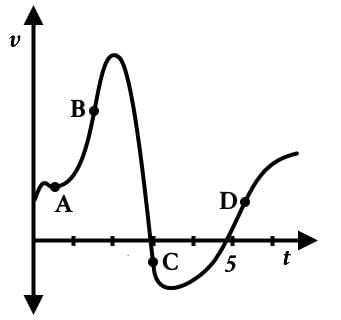MCAT Exam > MCAT Questions > According to the velocity-time graph below, h...
Start Learning for Free
According to the velocity-time graph below, how many times does the particle attain zero acceleration during the entire path?


- a)2
- b)3
- c)4
- d)5
Correct answer is option 'C'. Can you explain this answer?
Verified Answer
According to the velocity-time graph below, how many times does the pa...
On a velocity-time graph, there is zero acceleration whenever the particle goes from a positive to negative acceleration or vice versa.
Positive acceleration is indicated by tangents with positive slope like point B, and negative acceleration by tangents with negative slope like point C, so between point B and C at the maximum, there is zero acceleration.
Between C and D, there is a global minimum, which indicates zero acceleration.
Look for local minima and maxima, and there is a maximum before A and a minimum at A, so there are 4 instances.

|
Explore Courses for MCAT exam
|

|
Question Description
According to the velocity-time graph below, how many times does the particle attain zero acceleration during the entire path?a)2b)3c)4d)5Correct answer is option 'C'. Can you explain this answer? for MCAT 2025 is part of MCAT preparation. The Question and answers have been prepared according to the MCAT exam syllabus. Information about According to the velocity-time graph below, how many times does the particle attain zero acceleration during the entire path?a)2b)3c)4d)5Correct answer is option 'C'. Can you explain this answer? covers all topics & solutions for MCAT 2025 Exam. Find important definitions, questions, meanings, examples, exercises and tests below for According to the velocity-time graph below, how many times does the particle attain zero acceleration during the entire path?a)2b)3c)4d)5Correct answer is option 'C'. Can you explain this answer?.
According to the velocity-time graph below, how many times does the particle attain zero acceleration during the entire path?a)2b)3c)4d)5Correct answer is option 'C'. Can you explain this answer? for MCAT 2025 is part of MCAT preparation. The Question and answers have been prepared according to the MCAT exam syllabus. Information about According to the velocity-time graph below, how many times does the particle attain zero acceleration during the entire path?a)2b)3c)4d)5Correct answer is option 'C'. Can you explain this answer? covers all topics & solutions for MCAT 2025 Exam. Find important definitions, questions, meanings, examples, exercises and tests below for According to the velocity-time graph below, how many times does the particle attain zero acceleration during the entire path?a)2b)3c)4d)5Correct answer is option 'C'. Can you explain this answer?.
Solutions for According to the velocity-time graph below, how many times does the particle attain zero acceleration during the entire path?a)2b)3c)4d)5Correct answer is option 'C'. Can you explain this answer? in English & in Hindi are available as part of our courses for MCAT.
Download more important topics, notes, lectures and mock test series for MCAT Exam by signing up for free.
Here you can find the meaning of According to the velocity-time graph below, how many times does the particle attain zero acceleration during the entire path?a)2b)3c)4d)5Correct answer is option 'C'. Can you explain this answer? defined & explained in the simplest way possible. Besides giving the explanation of
According to the velocity-time graph below, how many times does the particle attain zero acceleration during the entire path?a)2b)3c)4d)5Correct answer is option 'C'. Can you explain this answer?, a detailed solution for According to the velocity-time graph below, how many times does the particle attain zero acceleration during the entire path?a)2b)3c)4d)5Correct answer is option 'C'. Can you explain this answer? has been provided alongside types of According to the velocity-time graph below, how many times does the particle attain zero acceleration during the entire path?a)2b)3c)4d)5Correct answer is option 'C'. Can you explain this answer? theory, EduRev gives you an
ample number of questions to practice According to the velocity-time graph below, how many times does the particle attain zero acceleration during the entire path?a)2b)3c)4d)5Correct answer is option 'C'. Can you explain this answer? tests, examples and also practice MCAT tests.

|
Explore Courses for MCAT exam
|

|
Signup for Free!
Signup to see your scores go up within 7 days! Learn & Practice with 1000+ FREE Notes, Videos & Tests.


















